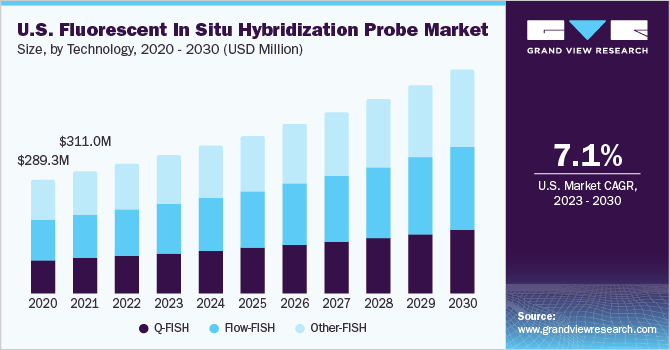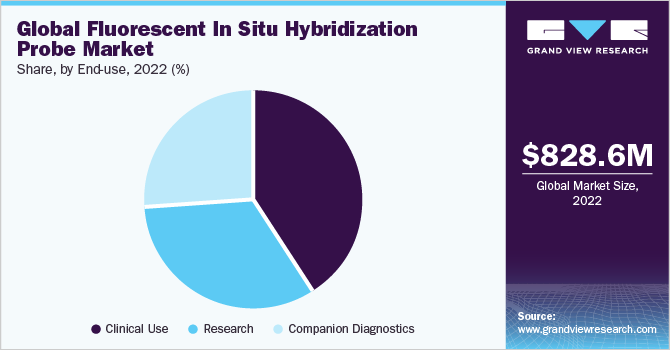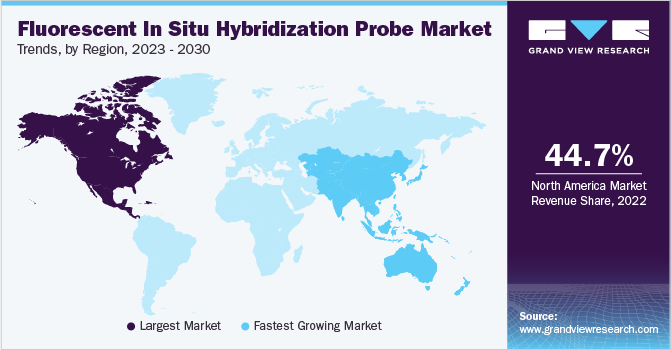- Home
- »
- Clinical Diagnostics
- »
-
Fluorescent In Situ Hybridization Probe Market Report, 2030GVR Report cover
![Fluorescent In Situ Hybridization Probe Market Size, Share & Trends Report]()
Fluorescent In Situ Hybridization Probe Market Size, Share & Trends Analysis Report By Technology (Flow FISH, Q FISH), By Type (DNA, RNA), By Application (Cancer Diagnosis, Genetic Diseases), By End-use (Research, Clinical), And Segment Forecasts, 2023 - 2030
- Report ID: 978-1-68038-596-0
- Number of Report Pages: 100
- Format: PDF, Horizon Databook
- Historical Range: 2018 - 2021
- Forecast Period: 2023 - 2030
- Industry: Healthcare
Report Overview
The global fluorescent in situ hybridization probe market size was estimated at USD 828.60 million in 2022 and is anticipated to grow at a compound annual growth rate (CAGR) of 7.6% from 2023 to 2030. The growth of the market is attributed to factors, such as an increasing demand for in vitro diagnostics (IVD), used in the diagnosis of various chronic diseases aided by the high levels of reliability, rapidity, and sensitivity associated with the technique. Moreover, over the years, diagnostics based on DNA probes have gained immense acceptance in medical diagnostics for the detection of diseases caused by bacteria or pathogens owing to the rising need for providing effective and early treatment. The COVID-19 pandemic has had a significant impact on the market due to the rising number of research studies incorporating fluorescent in situ hybridization (FISH).

For instance, in November 2022, an article in the PLOS One Journal showcased the use of a FISH-based assessment method for identifying SARS-CoV-2 in saliva. All saliva samples underwent FISH with a Cy3-labeled DNA probe specific to SARS-CoV-2, and subsequent analysis was manually conducted using microscopy fluorescence (as a proof-of-concept). The market is projected to exhibit a steady growth rate over the forecast period, primarily attributed to the growing global prevalence of cancer and genetic disorders. The identification of new areas for diagnostic markets, rapid automation of diagnostic tests, and investments in pharmacogenomics & pharmaceutical research propel the growth.
The increasing prevalence of genetic disorders, such as Acute Lymphoblastic Leukemia (ALL), is further anticipated to drive market growth. For instance, according to the American Cancer Society, nearly 6,500 new cases of ALL were diagnosed in 2023, leading to the death of 1,300 people in the U.S. The detection of cancer-related chromosomal abnormalities is significantly aided by cytogenetic techniques. According to the American Cancer Society Cancer Statistics for 2023, the U.S. is anticipated to witness the diagnosis of 1.9 million new cancer cases this year. Similarly, the Australian Institute of Health and Welfare's 2021 report projected an estimated 150,782 cancer cases in Australia in 2021.
Furthermore, the ICMR 2021 Report highlighted an anticipated increase in the number of cancer patients in India, expected to rise from 26.7 million in 2021 to 29.8 million by 2025. The substantial global burden of cancer underscores the effectiveness of FISH in disease diagnosis and treatment planning, driving growth within this specific segment. Increasing R&D initiatives by key players for the development of novel disease-specific biomarkers and pipeline products still waiting to get regulatory approval are also fueling market growth. Growing awareness among people coupled with a rise in healthcare expenditure and the development of novel probes are expected to drive market growth.
Technology Insights
Based on technology, the FLOW-FISH segment held the largest revenue share of 35.45% in 2022 and is anticipated to grow at the fastest growth rate over the forecast period. This is owing to the growing demand for genomic profiling by healthcare professionals. Flow FISH testing can automatically screen over 10,000 cells in around 10 minutes. This approach, in addition to improving testing efficiency and standardization, achieves greater repeatability than traditional manual FISH testing by measuring 20 to 100 times more cells. FLOW-FISH enables the study of individual cells at a genetic level while simultaneously capturing other cellular characteristics.
This is particularly important in fields, such as cancer research and immunology. The rising prevalence of chromosomal disorders is propelling the need for the product in the market. The technique is constantly being adopted for the diagnosis of Dyskeratosis congenita, the first inheritable disorder that is associated with the impaired maintenance of telomere. It is a rare condition that generally shows high prevalence in patients with bone marrow failure. Moreover, the rising prevalence of genetic disorders is propelling the need for the development of clinically advanced diagnostic procedures. However, the high cost associated with the technology is expected to hamper the growth of the market.
Type Insights
Based on type, the DNA segment held the largest revenue share of 58.04% in 2022 due to the rising demand for molecular profiling by healthcare professionals and the presence of molecular pathology tools that are technologically advanced and help in disease stratification and prognosis for appropriate treatment. The development of technologically advanced diagnostics tools is enabling the adoption of DNA probes in the market. For instance, in July 2023, KromaTiD announced the development of over 300 telomere, centromere, and gene probes for use in directional Genomic Hybridization (dGH) in-site DNA assays. The availability of a catalog of centromere and telomere probes empowers researchers and cytogenetic cores within the academic sphere to adopt these potent and advanced assays within their own facilities, all while maintaining cost-effectiveness.
The RNA probes segment is anticipated to register the fastest growth rate over the forecast period owing to the rising use of RNA probes for cancer analysis and the ability of RNA probes to differentiate between cancer subtypes. Novel probes targeting disease-specific RNA are being developed by companies, such as the Stellaris RNA probe by BioSearch technologies and the RNAscope series by Advanced Cell Diagnostics for infectious diseases and cancer. Recently approved FISH kits for companion diagnostic use include PATHYVISION HER- 2 by Abbott, INFORM HER 2/ NEU probe developed by F. Hoffmann-La Roche (Ventana Medical Systems), and HER2 FISH PharmDx by Dako Denmark.
Application Insights
Based on application, the cancer diagnostics segment held the largest revenue share of 43.99% in 2022. FISH probes are most commonly used in research for genetic diseases and cancer diagnostics. Increasing cancer incidences across the globe, which lead to the rising demand for sensitive, rapid, and accurate molecular diagnostic tests, are propelling the market growth. In cancer diagnostics, these probes are widely used for the diagnosis of breast and lung cancer. The development of novel diagnostics using FISH technology is further driving market growth. For instance, the UroVysion FISH test kit is used for the diagnosis of urological cancers.
On the other hand, owing to its advantages of exceptional detection precision, heightened sensitivity, and robust experimental duration, the utilization of FISH technology coupled with a fluorescent microscope has progressively enhanced the preference of these probes in cytogenetic analysis. FISH demonstrates remarkable efficacy in identifying anomalies within the MET (hepatocyte growth receptor factor) gene in non-small cell lung cancer as well as in detecting genes related to breast cancer. These factors aided by the high sensitivity and efficient testing capabilities associated with FISH probes are anticipated to drive the growth of the cancer diagnostics application segment.
End-use Insights
Based on end-use, the clinical use segment dominated the market with a revenue share of 41.32% in 2022 due to the wide application of FISH probes in the detection and diagnosis of genetic disorders, cancer, and infectious diseases. Fluorescence in situ hybridization is a commonly adopted technology used for the diagnosis of genetic abnormalities. They are commonly used in clinical procedures, companion diagnostics, and research studies. The specificity & high sensitivity of this technology and the rapid assays performing speed have made this technique an important cytogenetic test that offers significant benefits in research and diagnostic studies of hematological malignancies and solid tumors.

These probes are used in research studies for gene mapping, genetic aberrations, and the identification of novel oncogenes in cancer detection and treatment. It is also used in molecular-based testing for gene mapping and identification of novel oncogenes. The clinical and microbiological detection approaches have been greatly influenced by FISH, largely attributed to its high specificity and efficiency. This makes the technology one of the most commonly adopted techniques for clinical microbiological detection. Extensive studies on genetic abbreviation associated with diseases and the increasing prevalence of genomic abnormalities & cancer are some of the major factors driving the segment growth.
Regional Insights
North America accounted for the largest revenue share of 44.68% in 2022. The dominance of the region is attributed to the rising prevalence of genetic disorders leading to birth defects, developmental disabilities, and other metabolic syndromes. According to the CDC, in 2022, around 3-4% of newborns in the U.S. were born with some form of genetic abnormality, accounting for hospitalization of approximately 10% of adults and 30% of children. FISH is estimated to provide 98% accuracy in the detection of chromosomal aberrations leading to genetic abnormalities, which further propels the growth of the market in the region.

Moreover, usage of these assays in various disease areas, such as cancer and genetic disorders, is increasing and is further anticipated to drive the demand. Favorable healthcare reimbursement policies and government reforms are anticipated to fuel market growth. Asia Pacific is anticipated to register the fastest growth rate over the coming years on account of the presence of supportive government initiatives pertaining to the increasing investments by the government and key manufacturers in the biotechnology sector posing high untapped opportunities the for development of novel diagnostics in the region.
According to the NCBI, the Chinese government has been heavily investing in biotechnology R&D with investment increasing from USD 99 million in 2005 to USD 3.8 billion over the period 2008-2020. The rapid growth of the region is due to an increasing revenue generation from molecular and cytogenetics diagnostic sectors in this region. Moreover, continuous R&D activities for cancer diagnostics are facilitating the demand for cancer research aided by the growing adoption of novel techniques for molecular-based cytogenetics, and the rising demand for early diagnosis and detection of diseases.
Key Companies & Market Share Insights
The market is highly competitive due to the presence of key companies, which hold the majority of the market share owing to their extensive product portfolio. Companies are adopting competitive strategies, such as new product developments, regional expansions, and strategic collaborations, to gain an advantage. For instance, in March 2023, KromaTiD announced the launch of the dGH in-Site CAR-T Kit. The dGH technology is found to be unique among all other FISH techniques and the kit is found to be helpful for researchers in tracking T-cell engineering impacts. Some of the key players operating in the global fluorescent in situ hybridization probe market include:
-
Thermo Fisher Scientific Inc.
-
Perkinelmer Inc.
-
BioDot
-
Horizon Diagnostics
-
Agilent Technologies, Inc.
-
Abnova Corporation
-
LGC Biosearch Technologies
-
Genemed Biotechnologies, Inc.
-
Oxford Gene Technology IP Limited
-
Biocare Medical, LLC.
-
QIAGEN (Exiqon A/S)
-
GSP Research Institute, Inc.
Fluorescent In Situ Hybridization Probe Market Report Scope
Report Attribute
Details
Market size value in 2023
USD 0.88 billion
Revenue forecast in 2030
USD 1.49 billion
Growth rate
CAGR of 7.6% from 2023 to 2030
Base year for estimation
2022
Historical data
2018 - 2021
Forecast period
2023 - 2030
Report updated
September 2023
Quantitative units
Revenue in USD million/billion and CAGR from 2023 to 2030
Report coverage
Revenue forecast, company ranking, competitive landscape, growth factors, and trends
Segments covered
Type, technology, application, end-use, region
Regional scope
North America; Europe; Asia Pacific; Latin America; MEA
Country scope
U.S.; Canada; UK; Germany; France; Italy; Spain; Denmark; Norway; Sweden; China; Japan; India; Australia; South Korea; Thailand; Brazil; Mexico; Argentina; Saudi Arabia; South Africa; UAE; Kuwait
Key companies profiled
Thermo Fisher Scientific Inc.; Perkinelmer Inc.; BioDot; Horizon Diagnostics; Agilent Technologies, Inc.; Abnova Corp.; LGC Biosearch Technologies; Genemed Biotechnologies, Inc.; Oxford Gene Technology IP Ltd.; Biocare Medical, LLC; QIAGEN (Exiqon A/S); GSP Research Institute, Inc.
Customization scope
Free report customization (equivalent up to 8 analyst’s working days) with purchase. Addition or alteration to country, regional & segment scope
Pricing and purchase options
Avail customized purchase options to meet your exact research needs. Explore purchase options
Global Fluorescent In Situ Hybridization Probe Market Report Segmentation
This report forecasts revenue growth at global, regional, and country levels and provides an analysis of the latest trends in each of the sub-segments from 2018 to 2030. For this study, Grand View Research has segmented the fluorescent in situ hybridization probe market report on the basis of technology, type, application, end-use, and region:
-
Technology Outlook (Revenue, USD Million, 2018 - 2030)
-
Flow FISH
-
Q FISH
-
Other FISH
-
-
Type Outlook (Revenue, USD Million, 2018 - 2030)
-
DNA
-
RNA
-
mRNA
-
miRNA
-
Other
-
-
-
Application Outlook (Revenue, USD Million, 2018 - 2030)
-
Cancer Research
-
Lung
-
Breast
-
Bladder
-
Hematological
-
Gastric
-
Prostrate
-
Cervical
-
Other
-
-
Genetic Diseases
-
Other
-
-
End-Use Outlook (Revenue, USD Million, 2018 - 2030)
-
Research
-
Clinical
-
Companion diagnostics
-
-
Regional Outlook (Revenue, USD Million, 2018 - 2030)
-
North America
-
U.S.
-
Canada
-
-
Europe
-
UK
-
Germany
-
France
-
Italy
-
Spain
-
Sweden
-
Norway
-
Denmark
-
-
Asia Pacific
-
China
-
Japan
-
India
-
Australia
-
Thailand
-
South Korea
-
-
Latin America
-
Brazil
-
Mexico
-
Argentina
-
-
Middle East & Africa
-
Saudi Arabia
-
South Africa
-
UAE
-
Kuwait
-
-
Frequently Asked Questions About This Report
b. The global fluorescent in situ hybridization probe market size was estimated at USD 828.60 million in 2022 and is expected to reach USD 887.60 million in 2023.
b. The global fluorescent in situ hybridization probe market is expected to grow at a compound annual growth rate of 7.6% from 2023 to 2030 to reach USD 1.49 billion by 2030.
b. FLOW-FISH segment held the largest revenue share of 35.45% in 2022 and is anticipated to grow at the fastest growth rate over the forecast period in the fluorescent in situ hybridization (FISH) probe market owing to the growing demand for genomic profiling by healthcare professionals.
b. Some key players operating in the fluorescent in situ hybridization probee market include Oxford Gene Technologies; Life Science Technologies; PerkinElmer Inc.; Abnova Corporation; Biosearch Technologies Inc.; Genemed Biotechnologies, Inc.; and F. Hoffmann-La Roche AG.
b. Key factors that are driving market growth include increasing demand for In-vitro Diagnostics (IVD) testing for the diagnosis of various chronic diseases that provide a high level of reliability, rapidity, and sensitivity for FISH probe techniques,
Share this report with your colleague or friend.
![gvr icn]()
NEED A CUSTOM REPORT?
We can customize every report - free of charge - including purchasing stand-alone sections or country-level reports, as well as offer affordable discounts for start-ups & universities. Contact us now
![Certified Icon]()
We are GDPR and CCPA compliant! Your transaction & personal information is safe and secure. For more details, please read our privacy policy.
We are committed towards customer satisfaction, and quality service.
"The quality of research they have done for us has been excellent."





